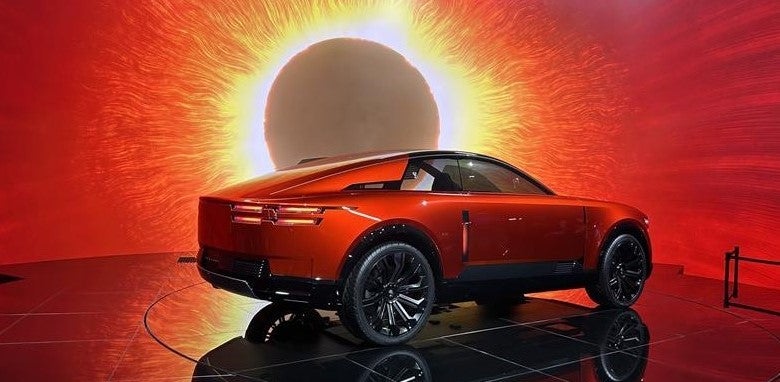Walking through the Tokyo Big Sight center in early November for the Japan Mobility Show 2025, you could feel two stories unfolding at once. On the surface, Japan’s hometown brands filled the halls with sharp concepts, plush interiors and a sea of “electrified” badges. However, underneath, something more cautious was just as clear—Japan still has not decided how far it really wants to go with full Battery Electric Vehicles (BEVs), even as China and Europe push hard in that direction.

The event, newly positioned as a broad “festival of mobility”, brought together everything from tiny Kei Cars and family Vans to personal air taxi mockups and energy management systems. It worked as much as an unwritten progress report as it did a show, revealing how Japan intends to defend its automotive base while the global industry moves toward stricter carbon rules and higher Electric Vehicle (EV) shares.
Hybrids rule at home, BEVs remain marginal
Japan remains the world’s fourth largest auto market, and it is still overwhelmingly domestic: Japanese brands accounted for almost 94% of registrations in H1 2025. Yet the powertrain mix in the country looks very different from Europe, China or even the US, as BEVs are still a niche. The number of BEV models has climbed from about 15 in 2019 to nearly 80 in 2025, but only around 16 of those are from Japanese brands, and most of the actual volume still comes from Kei segment BEVs such as the Nissan Sakura and Mitsubishi eK X EV.
At home, hybrids have become the default form of electrification. Many households now see a hybrid as a normal car that simply uses less fuel. BEVs and Plug-in Hybrids (PHEVs), by contrast, still only account for a thin proportion of new registrations. Overall Light Vehicle (LV) demand is slightly positive, with 2025 sales projected at 4.7 mn units, but BEVs are still barely visible in the mix at only 100k units, roughly 2.3% of total LV sales. By contrast, the hybrid wave is firmly mainstream, with volumes reaching around 1.3 mn units in 2025—a level they are expected to remain above through the end of this decade.
This stands in sharp contrast to China, where EVs already account for a very large share of sales, and to Europe, which is building policy around a firm end to new Internal Combustion Engine (ICE) sales in the next decade. Japanese brands are also losing share in key Southeast Asian markets as Chinese EV specialists push in with aggressive pricing and fast model cycles. The strategic pressure is obvious, but the response in Tokyo is still cautious and layered rather than dramatic.

US Tariffs are shifting - will you react or anticipate?
Don’t let policy changes catch you off guard. Stay proactive with real-time data and expert analysis.
By GlobalData
“Multi-pathway” thinking on stage
That caution was most visible on the Toyota and Lexus stands. Their hero concepts looked ready to star in showrooms or video games, with long bonnets, dramatic lighting signatures and high-tech cabins. Yet one key detail was missing from many of the display boards—there was no fixed powertrain label.
When speaking with engineer staff, the reasoning was consistent. These vehicles are intentionally “multi pathway”. The same basic package, they argue, could take an efficient ICE, a classic hybrid, a PHEV, a battery pack or even a hydrogen fuel cell system, depending on market and timing. The design comes first; the exact powertrain is left open.
Lexus carried this logic into the Premium space. The brand spoke at length about emotional design, immersive cabins and a connected luxury ecosystem on land, at sea and in the air. Electrification was everywhere in the language, but staff still avoided locking every flagship concept into a pure-BEV future.
Daihatsu, now firmly positioned as the Kei and entry arm of Toyota, sent the same message in miniature. Its stand included mixed Small EV concepts, smart hybrids and Conventional Kei proposals under a theme of flexible answers for urban and regional users. None of these brands presented BEVs as the inevitable end point. Instead, they treated technology choice as a virtue in itself.
It is a very different atmosphere from recent shows in Shanghai or Munich, where centerpiece products sit on dedicated BEV platforms and timelines for ending ICE sales are discussed openly. In Tokyo, the powertrain remains a variable that executives clearly prefer not to fix too early.
OEMs in brief, with Honda the Outlier
Honda was the one major Japanese OEM whose booth clearly revolved around a BEV roadmap. The core message was the Honda 0 Series, a family of next generation BEVs built around the “thin, light, wise” mantra. The new Honda 0 Alpha SUV prototype took center stage as an affordable gateway model targeted for launch around 2027, supported by the earlier 0 Saloon and 0 SUV concepts that will anchor the series globally.
Around this, Honda packed the stand with additional BEVs and strong EV signals. The Super-ONE Compact EV world premiere was positioned as a fun everyday city car, while the N-ONE e Mini EV showed how Honda wants to normalize Small BEVs for Japanese daily use. The CUV e city Crossover concept hinted at another volume slot in the lineup, and a full zone of battery powered two-wheelers and devices extended the electric story beyond four wheels. Fuel cell and hybrid CR-V prototypes were also present, but they felt like supporting acts. The overall impression was that Honda now sees BEVs as a core architecture it must scale, even if corporate investment plans have been trimmed and hybrids will remain important through the 2020s.
Mazda distilled Japan’s “many routes to carbon neutrality” mindset into its Vision X-Coupe concept. This sleek model uses a two-rotor turbo rotary engine running on carbon neutral fuel refined from microalgae, integrated into a PHEV system, plus an onboard “Mazda Mobile Carbon Capture” device that traps part of the exhaust CO₂. Mazda claims that, in combination, the algae derived fuel and capture system could make real world operation close to carbon negative. However, the algae fuel production is resource intensive and slow, with very low yields and high costs.
That makes large scale deployment doubtful for now. It is best read as a provocative technology demonstrator showing where Mazda’s engineering imagination is heading rather than a realistic mass market solution.
On the other hand, Nissan offered one of the most practical electric ideas on the floor. A Sakura-based Small Van equipped with a solar extender package used fixed and fold out panels on the roof and sides to generate useful energy over the course of a year in Japanese conditions and to serve as an emergency power source. It was a very Japanese answer to apartment charging constraints and disaster resilience, and it underlined Nissan’s strength in energy management, yet it also framed BEVs as part of a wider energy service proposition rather than as the automatic replacement for every combustion model.
Elsewhere, Mitsubishi, Subaru and Suzuki reinforced the broader pattern in their own corners of the market. Mitsubishi refreshed its “Forever Adventure” story with the Elevance electrified Crossover and rally-inspired Triton hardware, signaling a continued focus on plug-in capable SUVs rather than a sudden swing to mass BEVs. Subaru split its performance future between the all-electric Performance E STI concept and a petrol Performance B STI sibling, supported by rugged Wilderness-branded Forester and Outback variants for outdoor lifestyles. Suzuki concentrated on Kei and Compact value with the Vision e Sky BEV concept, flex fuel ideas aimed at markets such as India, and a set of updated micro mobility platforms under its “By Your Side” slogan. All three brands showed serious electrification work, but all three stressed customer choice, from hybrids and plugs to low cost EVs and alternative fuels.
Can “Optionality” survive a harder BEV world?
The Japan Mobility Show 2025 captured a very specific tension. Europe and China are gradually normalizing a world where BEVs are treated as the main answer, while Japan is fielding an impressive range of technology, but still refuses to present BEVs as the endgame.
There are clear reasons for this caution. Domestic BEV demand is weak, charging infrastructure is uneven, electricity is not especially cheap, and hybrids are profitable and popular. Japanese OEMs still earn strong margins on efficient combustion and hybrid exports, and the brutal price competition in China’s EV market is a warning as much as an example.
The risk is that the outside world settles the argument earlier than Tokyo expects. If major markets lock in stricter zero emission rules and BEVs continue to gain share, Japan’s multi pathway strategy could leave its OEMs under invested in dedicated BEV platforms, batteries and software.
In the short term, the multi pathway strategy remains rational. Hybrids and Plug-in Hybrids deliver large emissions cuts and strong cash flow, while BEVs and Kei BEVs grow where they make the most sense. The open question is how long Japan can keep every route on the table before regulation, customers and competitors force its champions to choose a single main path.
Kunat Tharasrisuthi, Manager, Asia Powertrain Forecast
This article was first published on GlobalData’s dedicated research platform, the Automotive Intelligence Center.







